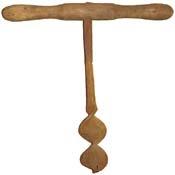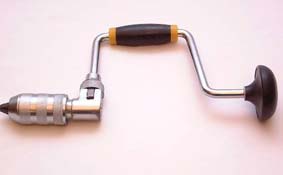Tapping

The Native Americans made a “tap hole” by gashing an opening in the tree with a sharp stone. The pioneers first drilled with a hand bit and brace with which they could drill about 800 holes a day. Today a 35 to 40 pound gas powered drill is used, enabling a person to tap approximately 2000 holes in a day’s time. The heat produced by the drill may cause the hole to cauterize inhibiting sap flow.
It takes approximately forty years to grow a maple tree large enough to tap. A rule almost universally accepted is never to tap a tree less than 10 to 12 inches in diameter. The old farmer’s rule had it just right: “Never tap a tree smaller than the bucket you’re putting on it.” For each 5 inches growth in tree diameter, another tap hole may be made (10”-12” = 1 bucket, 15”-17” = 2 buckets, etc.). Generally there is a four-bucket limit placed on tap holes, as tree growth (annual rings) is extremely slowed beyond 25 inches in trunk diameter. There is considerable debate about the so-called tapping guidelines. Some foresters suggest that no more than two tap holes per tree as a guideline as opposed to the old guideline of “put out enough spouts to make a living.”
The diameter of the tap hole is 7/16 inch. The hole is drilled at a slightly upward angle to a depth of 3 inches. This area is the living part of the tree or sapwood and is where the sap flows. The inner part of the tree, the heartwood, is non-conducting dead cells. The height of the tap hole is generally 3 to 4 feet above ground or chest height, primarily for convenience in emptying containers and clearing root knobs. A tap hole will “dry up” in 3 to 4 weeks due to growth of microorganisms that feed on the sap in the opening not to the air-drying of the wood tissue. Tap holes should be allowed to “scar over” or heal and not be used again. Future tap holes should be placed 4 to 6 inches away in any direction from old tap holes.

